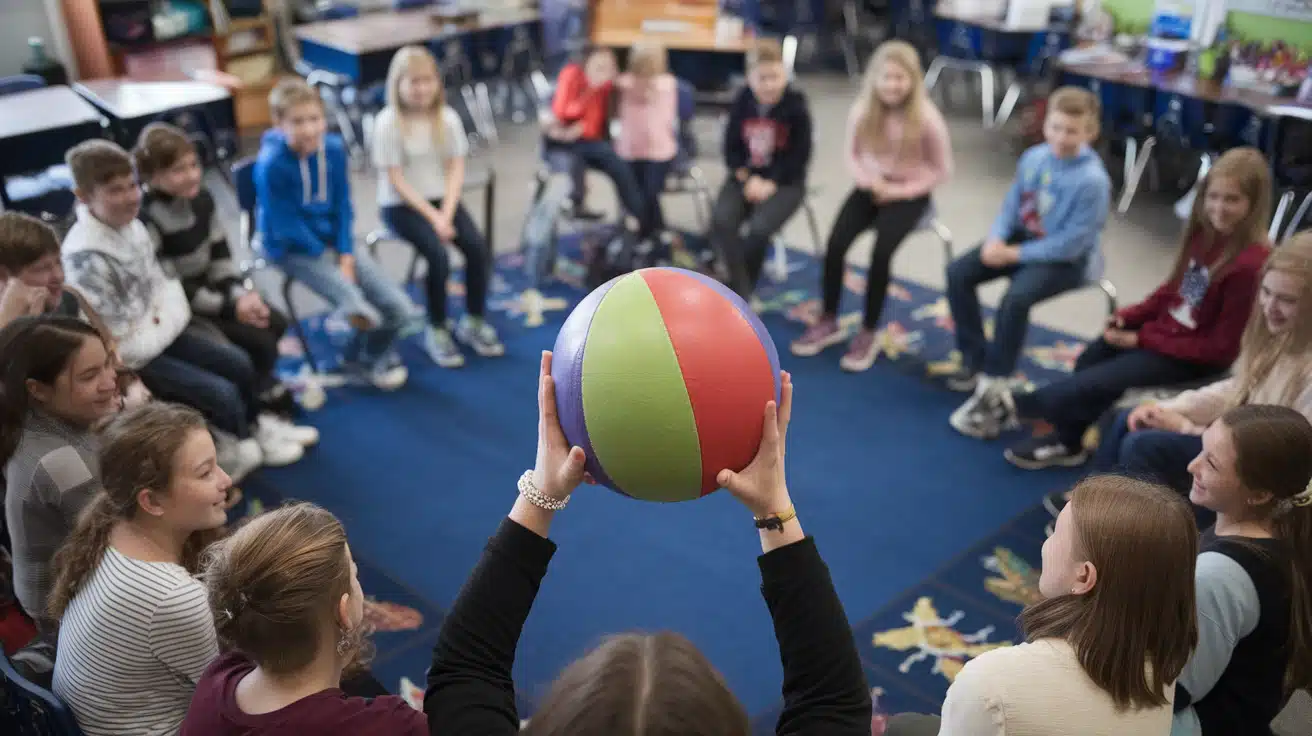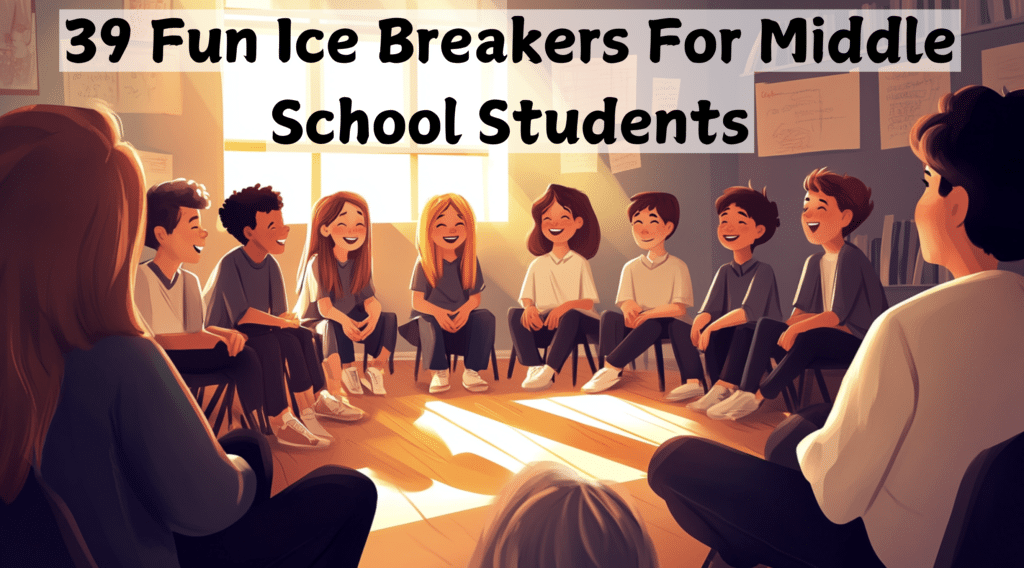Would everyone rather write an essay or speak in front of the class?
Most middle school students would pick the essay – that’s how much they dread those first moments of speaking up in a group of peers.
Starting conversations and making new friends can feel tricky for students aged 11-14.
The usual “tell us your name and one fact” routine often leads to nervous silence or bored sighs. Many teachers see their students struggle with social anxiety during group activities or class discussions.
This collection of 39 carefully selected icebreakers turns awkward moments into fun opportunities for connection.
From quick partner activities to whole-class games, each one helps students feel comfortable and naturally builds classroom community.
These icebreakers go beyond basic introductions to spark real conversations, create shared laughs, and help middle schoolers get to know their classmates meaningfully.
How To Choose The Right Ice Breakers For Middle School
Consider The Group Size
Small groups of 5-10 students work well with personal sharing activities like “Two Truths and a Lie” or “Show and Tell.” These settings help students feel more comfortable speaking up.
For larger groups of 20-30 students, movement-based games like “Find Someone Who” or “Human Bingo” work better. These activities let many students interact at once without putting too much focus on any single person.
Tailor Activities To Age And Interests
Middle school students respond well to activities that relate to their daily lives.
Include topics about favorite music, social media platforms, or current trends. Avoid childish themes that might make students feel talked down to.
Instead, pick topics that allow them to share their opinions and experiences with movies, sports, or video games.
Keep It Simple And Engaging
Clear rules make activities fun for everyone. Provide short, step-by-step instructions that students can follow easily.
Test the activity’s length—anything over 15 minutes might cause students to lose interest. Make sure every student has a chance to join in. The best activities get students moving, talking, and laughing together without complex rules or long explanations.
39 Creative Ice Breakers To Energize Middle School Students

1. Two Truths And A Lie
Two Truths and a Lie is a fun and engaging game in which students share facts about themselves while keeping their peers guessing. This game encourages creativity and helps students learn more about each other.
How to Play
- Ask each student to think of two true statements and one false statement about themselves.
- Students take turns sharing their three statements with the class.
- The other students guess which statement is the lie.
- Reveal the lie and rotate to the next student.
2. Would You Rather
Would You Rather is a simple game that gets students talking. It presents them with two fun or thought-provoking options.
How to Play
- Prepare a list of “Would you rather” questions (e.g., “Would you rather fly or be invisible?”).
- After reading each question aloud, have students vote on their choice by raising their hands or moving to a designated side of the room.
- Discuss the choices briefly to spark conversations and laughter.
3. Human Knot
Human Knot is a physical and cooperative game that challenges students to work together to solve a “human puzzle.”
How to Play
- Students stand in a circle, shoulder to shoulder.
- Each student reaches out and holds hands with two different people, creating a tangled “knot.”
- Without letting go of each other’s hands, the group works together to untangle themselves into a circle.
4. All About Me Poster
All About Me Poster allows students to express themselves creatively while sharing details about their lives and interests.
How to Play
- Provide each student with a blank poster board or a large sheet of paper.
- Instruct them to include their name, favorite hobbies, family details, and fun facts using drawings or words.
- Each student presents their poster to the class.
5. Find Someone Who
Find Someone Who is an interactive game that helps students discover shared interests or experiences with their peers.
How to Play
- Prepare a bingo-style sheet with prompts like “Find someone who has a pet cat” or “Find someone who loves ice cream.”
- Students mingle and ask each other questions to complete their sheets.
- The first student to fill out their sheet or collect the most responses wins.
6. Speed Friending
Speed Friending is a fast-paced way for students to meet and talk to many classmates in a short period of time.
How to Play
- Arrange desks or chairs in pairs.
- Students sit across from a partner and have one minute to chat and introduce themselves.
- Rotate students to the next partner when time is up.
- Repeat until all students have met.
7. Name That Tune
Name That Tune is a lively game where students identify songs based on short snippets of music.
How to Play
- Play a 5-10-second clip of a song (can be from a playlist or your phone).
- Students guess the song title or artist.
- Award points for correct answers and tally scores to find a winner.
8. Silent Line-Up
Silent Line-Up challenges students to communicate nonverbally as they organize themselves into a specific order.
How to Play
- Instruct students to line up by criteria like birthdays, height, or alphabetical order.
- Set a rule that no one can speak during the process.
- Observe and discuss how they succeeded or where they struggled.
9. Mystery Bag
Mystery Bag is an imaginative game where students create a story based on a random object they pick from a bag.
How to Play
- Fill a bag with various random objects like a toy car, a key, or a scarf.
- Students take turns pulling an item from the bag without looking.
- Each student makes up a short story about the object they selected and shares it with the class.
10. This or That
This or That is a simple game that encourages students to consider their preferences and bonds them over shared choices.
How to Play
- Call out pairs of choices like “cats or dogs” or “beach or mountains.”
- Students move to one side of the room or raise their hands to indicate their choice.
- Optionally, ask students to explain why they made their choice to spark discussion.
11. Emoji Introductions
Emoji Introductions let students use creativity and technology to express their personalities.
How to Play
- Ask each student to choose three emojis that represent them.
- Students share their emojis with the class and explain their significance.
- Encourage others to ask questions or share similar interests.
12. Favorite Things
Favorite Things is a quick icebreaker where students share their personal likes, creating connections through common interests.
How to Play
- Have students introduce themselves and share their favorite things (e.g., food, movie, or hobby).
- Encourage follow-up questions or comments to keep the conversation flowing.
13. Snowball Fight
Snowball Fight adds a physical and fun element to getting-to-know-you activities.
How to Play
- Students write a fun fact about themselves on a piece of paper and crumple it into a “snowball.”
- Toss the snowballs around the room for a minute.
- Each student picks one up, reads it, and tries to guess who wrote it.
14. Pictionary
Pictionary is a creative and fast-paced drawing game that tests students’ artistic and guessing skills.
How to Play
- Divide the class into teams.
- One student from each team draws a word or phrase while their teammates guess.
- Rotate players, and the team with the most correct guesses wins.
15. Charades
Charades get students moving and thinking as they act out words or phrases for their peers to guess.
How to Play
- Write prompts on slips of paper and put them in a bowl.
- One student picks a slip and acts out the word or phrase without speaking.
- The rest of the class guesses until someone gets it right.
16. Paper Airplane Questions
Paper Airplane Questions combine creativity and curiosity by turning questions into flying objects.
How to Play
- Each student writes a question on a piece of paper and folds it into a paper airplane.
- Students throw their airplanes across the room.
- Each person picks up one and answers the question on it.
17. Scavenger Hunt
Scavenger Hunt gets students exploring their surroundings to find clues or complete a checklist.
How to Play
- Prepare a list of items or clues related to the classroom or school environment.
- Divide students into teams and give them the list.
- The team that finds all the items first wins.
18. Stand Up If
Stand Up If encourages active participation and helps students learn about each other’s experiences.
How to Play
- Call out statements like “Stand up if you’ve been to a zoo.”
- Students who relate to the statement stand up.
- Discuss or laugh about the shared experiences.
19. Group Jigsaw Puzzle
Group Jigsaw Puzzle fosters teamwork as students work together to complete a challenge.
How to Play
- Divide students into small groups.
- Give each group a bag of puzzle pieces.
- The first group to complete their puzzle wins.
20. Back-to-Back Drawing
Back-to-back drawing emphasizes listening and descriptive skills in a fun activity.
How to Play
- Pair students and have them sit back-to-back.
- One student describes an image, and the other tries to draw it based on the description.
- Compare drawings to see how close they are to the original.
21. Marshmallow Tower
Marshmallow Tower combines creativity and teamwork as students compete to build the tallest structure.
How to Play
- Provide each team with spaghetti, tape, and marshmallows.
- Set a time limit for building the tallest freestanding tower.
- Measure the towers and the tallest wins.
22. Memory Circle
Memory Circle challenges students’ memory skills while learning about their peers.
How to Play
- The first student says their name and a hobby or interest.
- The next student repeats the first student’s information and adds their own.
- Continue until all students have participated.
23. Classroom Bingo
Classroom Bingo adds a competitive twist to learning fun facts about classmates.
How to Play
- Create a bingo card with prompts like “plays a sport” or “has a sibling.”
- Students mingle to find classmates who match the prompts and fill out their cards.
- The first student to complete a row shouts, “Bingo!”
24. Word Association
Word Association sparks creativity and quick thinking in a group setting.
How to Play
- Start with a random word.
- Each student takes turns saying a word related to the previous one.
- Continue until someone hesitates or repeats a word.
25. Guess Who?
Guess Who helps students learn about their peers by guessing which fun fact belongs to whom.
How to Play
- Ask each student to write a fun fact about themselves on a piece of paper.
- Collect and read the facts aloud one by one.
- The class guesses which student matches the fun fact.
26. Story Chain
Story Chain fosters creativity as students collaborate to create a unique story.
How to Play
- One student starts with a sentence to begin a story.
- Each student adds one sentence to continue the narrative.
- Continue until everyone has contributed, and read the story aloud.
27. Quick Doodles
Quick Doodles challenges students to create fun sketches under a time limit.
How to Play
- Provide students with paper and markers.
- Call out a simple prompt (e.g., “a tree,” “a funny face”), and give them 30 seconds to draw.
- Share the drawings with the class for laughs.
28. Reaction Wheel
Reaction Wheel is an expressive game that encourages students to showcase emotions.
How to Play
- Create a wheel with emotions (e.g., happy, surprised, angry).
- Spin the wheel, and students take turns acting out the chosen emotion.
- Optionally, have the class guess the emotion being acted out.
29. Pass the Clap
Pass the Clap is an energizing game that tests rhythm and teamwork.
How to Play
- Students stand in a circle.
- One student starts by clapping in a rhythm, and the next person repeats it.
- The clap continues around the circle. If someone misses, they are out, and the circle gets smaller.
30. Categories Game
Categories Game challenges students to think quickly while staying within a topic.
How to Play
- Choose a category (e.g., fruits, animals).
- Students take turns naming something in the category without repeating it.
- The game continues until someone hesitates or repeats an answer.
31. I Spy
I Spy is a classic game that helps students sharpen observation skills.
How to Play
- One student starts by saying, “I spy with my little eye, something [color/shape].”
- Others take turns guessing the object.
- The first to guess correctly gets the next turn.
32. The Shrinking Circle
The Shrinking Circle is a team-building activity that encourages creative problem-solving.
How to Play
- Place a large hula hoop on the floor.
- Students stand inside it. Gradually shrink the space (e.g., fold the hoop or add another student).
- The goal is to fit everyone without stepping out.
33. Talent Show Minute
Talent Show Minute allows students to share a unique skill or talent with the class.
How to Play
- Give each student one minute to perform a talent (e.g., singing, magic tricks, or juggling).
- Celebrate and encourage each student’s effort.
34. Mad Libs
Mad Libs is a humorous game where students fill in blanks to create funny stories.
How to Play
- Provide a story template with blanks for nouns, verbs, and adjectives.
- Students suggest random words to fill in the blanks.
- Read the completed story aloud for laughs.
35. Guess the Teacher
Guess the Teacher is a mystery game that helps students connect with their instructors.
How to Play
- Teachers write fun facts about themselves on slips of paper.
- Read the facts aloud, and students guess which teacher they belong to.
36. Sticky Note Goals
Sticky Note Goals is a motivational activity where students share aspirations.
How to Play
- Provide each student with a sticky note to write a goal or dream.
- Stick the notes on a board or wall, and let students read and discuss them.
37. Rock-Paper-Scissors Tournament
Rock-Paper-Scissors Tournament is a fun way to foster friendly competition.
How to Play
- Pair students to play rock-paper-scissors.
- Winners advance to the next round until there’s a final champion.
- Celebrate the winner with a small prize or applause.
38. Personal Shield
Personal Shield is a creative project where students design symbols to represent themselves.
How to Play
- Give students a blank shield template.
- Ask them to fill it with symbols or drawings that represent their personality, hobbies, or goals.
- Students present their shields to the class.
39. What’s Your Superpower?
What’s Your Superpower sparks the imagination as students share their dream abilities.
How to Play
- Ask each student to imagine having a superpower.
- They share their power and explain how they would use it.
- Encourage creative answers and discussions.
Conclusion
Making your classroom a place where students feel comfortable takes time.
These icebreakers do more than get students talking – they help build trust and understanding between classmates.
Real learning can begin when students feel safe sharing their thoughts and experiences.
Every time I see previously quiet students raise their hands to participate or notice new friendships forming across different social groups, I’m reminded why these simple activities matter.
The small moments of connection created through these icebreakers often lead to better class discussions, increased participation, and a more positive learning environment throughout the year.
Remember – starting small with just one or two activities can make a big difference in your classroom.















